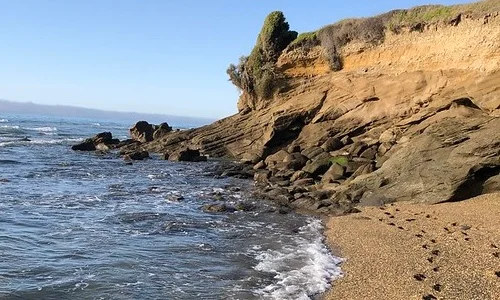This is my first batch of tumbling Kakanui stones! In early September we spent the weekend just outside of Oamaru specifically to explore the beaches at and around Kakanui. In particular these stones were collected in my first visit to Seadown Beach (so named by JP here) in the afternoon of our arrival!
I think that recent stormy weather has resulted in a lot more sand and a lot less stones than usual but I did manage to find a few keepers! The beach was completely deserted but the road was very busy!
The Kakanui stones I picked up were a lot smoother than the ones I pick up at Gemstone Beach. Now I need to learn what they are! Lucky I know “a guy” who blogs and shares a load of info about the stones he gathers for tumbling! If you’re not following his blog – you really ought too!
Here’s a excerpt from his post Thirty New Zealand Stones for USA Part Two: Ten from Kakanui:
Many of the stones on this beach in Kakanui are quartzites. A quartzite starts off as a quartz-rich sandstone, a sedimentary rock that is grainy and feels like sandpaper. When the sandstone is exposed to high temperatures and pressures, the hard glassy metamorphic rock of quartzite is formed. Quartzite’s wide variety of colours are a result of minor amounts of different minerals being incorporated with the quartz during the process of metamorphism.
Jp, Tumblestoneblog.wordpress.com
Jasper is different from quartzite but is related, with quartz being the common denominator. Quartz is silicon dioxide (SiO2) and is the most abundant mineral found on the Earth’s surface. Jasper is an opaque form of chalcedony which is a cryptocrystalline form of silica. Chalcedony arises when quartz crystals forms at low temperatures in volcanic cavities. The crystals can be so small that they are visible only when magnified, which is the meaning of the term “cryptocrystalline”. Chalcedony comes in a vast array of colours and patterns which gives rise to a wide range of different stones. These include blood-red carnelian, wine-red jasper, brown-banded agate, green-moss agate, apple-green chrysoprase, and black and white onyx. The colour depends on what minerals seep into the rock. The presence of iron causes the red colour in jasper, but jasper can also be green, yellow and brown when other minerals are present instead.
It can often be difficult to decide whether some dark red stones are quartzite or jasper.
Batch 30: 3lb Tumbler 1
Stage 1: 80/100grit
Number of Stones: 68
Weight in: 1108g
4 Tbspns of 80/100grit – no pellets
Days Tumbling: 11
Weight out: 907g – loss of 201g
Stage 2: 220grit
Number of Stones: 64 (4 removed for redo)
Weight in: 793g
4 Tbspns of 220grit – pellets added
Days Tumbling: 10
Weight out: 757g – loss of 36g
Stage 3: 400grit
Number of Stones: 64 + 5 (added from redo box)
Weight in: 838g
4 Tbspns of 400grit – pellets added
Days Tumbling: 10
Weight out: 793g – loss of 45g
Soap Tumble: 24hrs
There were not enough stones in this batch to polish in the 4lb tumbler straight away. These stones were placed into a water tray to await the finish of the grit tumbles for Batch 34 (also Kakanui stones).
Batch 30: Pre-tumble
Added to Stage 3
Transfer to 4lb Tumbler 2
This tumbler load ended up with several combined batches which is unusual and a little tricky to keep track of! Into the tumbler went this batch (30) plus Batch 34 plus Batch 37 (which completed all the grit stages in this tumbler). All of the stones (regardless of which batch they are) are from my recent trip to Kakanui.
There was a slight difference in my usual stages of tumbling too for these stones. I added a 600grit tumble due to quite a bit of what I think is “bruising” of stones. There were a number of stones with surface “pits” and I thought that a tumble in 600grit might smooth those out without grinding away too much more of the stones.
Stage 3b: 600grit
Number of Stones: 132+69=201
Weight in: 1772g
7 Tbspns of 600grit – pellets added
Days Tumbling: 10
Weight out: 1662g – loss of 110grams
+ 3 hour Soap Tumble pre polish
Stage 4: Polish Mix
Number of Stones: 201
Weight in: 1644g
Polish Mix (2nd use): 9 Tbspns of polish mixed with 600mls of clean water. Pellets added.
Days Tumbling: 10
Weight out: g – loss of:
Stage 5: Burnish
Despite a really good soapy rinse there were still a number of stones with polish residue so I decided to do a burnish tumble for 3 days using 2 Tablespoons of borax and cushion pellets to finish the three combined batches off.
I do believe that the 600grit tumble made a big difference to the stones and I wrote in my log that I was excited to see how this batch turns out. Even though Batch 30 was the first of the Kakanui stones I tumbled, another batch ended up coming out a polish tumble before this one! I’m being more particular these days with how many stones are loaded into the tumbler and I’m sticking to the 2/3rds rule using a marker each time to ensure that I’m not overfilling (or underfilling) the barrels.
Polished Stones of Interest: Batch 30
Batch 30 | 3lb Tumbler 1 | Kakanui (plus 5 redos from B26) | 11 September – 11 October
4lb Tumbler 2 | Batch 30, Batch 34, Batch 37 | Kakanui | 15 December – 28 December 2023












One Reply to “Batch 30: First Batch Tumbling Kakanui Stones”